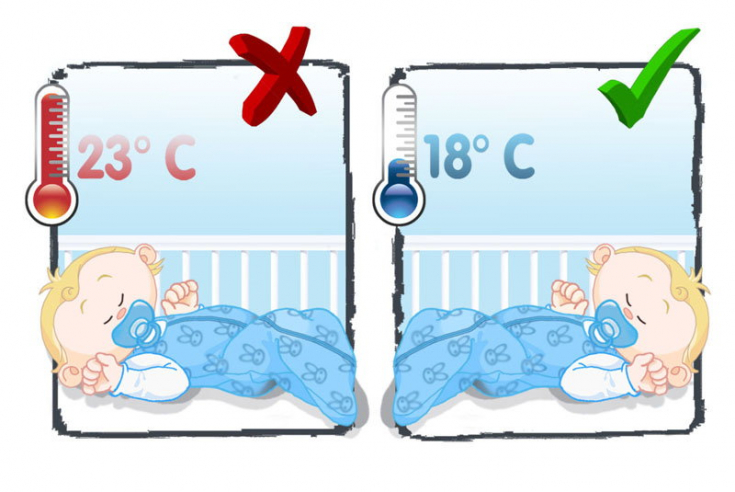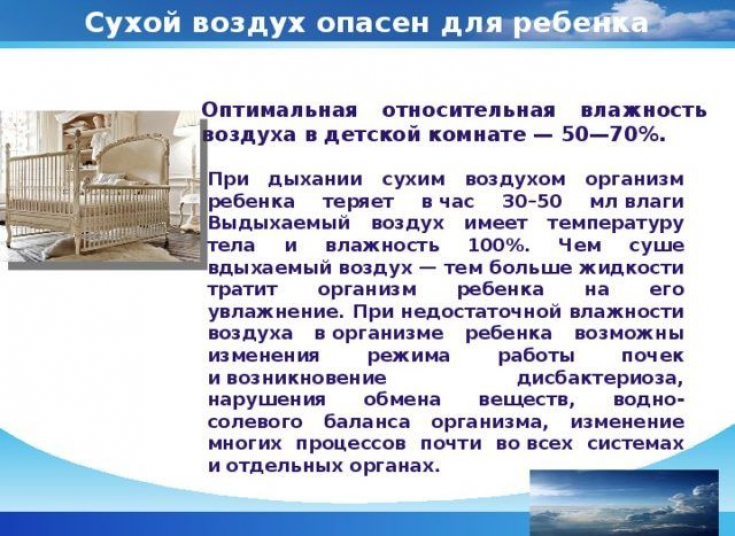The level of air humidity for a child is directly related to his health. From the first days of a little person's life, it is necessary to maintain optimal humidity and temperature parameters in the children's room. The child will feel more comfortable, less sick and easier to recover. Not in vain, the famous pediatrician Evgeny Komarovsky does not get tired of saying that the humidifier and hygrometer — one of the first and important purchases of young parents. We understand why this is so important and what norms should be followed.
- Humidity and air temperature for a child: optimal parameters and impact on health
- Why is it important to maintain optimal humidity and temperature in room
- Why does the air get too dry in rooms
- How to Humidify the Air: Effective Ways to Combat Dry Air
Humidity and air temperature for a child: optimal parameters and impact on health
Many parents are afraid of overcooling the child, so the room and the child himself are carefully insulated. But they forget one important point — heat exchange in children differs from heat exchange in an adult. An adult and a child feel the air temperature differently. When the mother is cool, this temperature will be comfortable for the child. If an adult is hot, then this already threatens small children with overheating. Pediatricians warn that overheating in this case is much more dangerous than hypothermia.
Relative air humidity — another important parameter for the health of the child. You can measure the humidity level in a room using a hygrometer.
Optimal norms for humidity and temperature in rooms:
-
Humidity — 50-70%
-
Air temperature — 19-22 °С
If the child has a cold, then the parameters will be slightly different. Doctors advise to dress the child warmly, but provide him with clean and cool air. Humidity should be maintained at level 60-80%.

Read also: Viral infection in children: how to avoid
Why is it important to maintain optimal humidity and temperature in room
-
Children tolerate dry and warm air worse than adults. There is a lot of dust in such a room, which settles not only on furniture, but and on the child respiratory tract. This can escalate into frequent respiratory illnesses, dust allergies & asthma.
-
The body doesn not get enough oxygen, which is why children are more likely to get tired, irritated, lose concentration.
-
Dry air causes drying of the mucous membranes. In such a room, the risk of contracting infections that are transmitted by airborne droplets increases.
-
By inhaling dry air, the child's body dehydrates faster. This is especially dangerous if the child is sick, does not say that he is thirsty or is not used to drinking water.
-
Skin dries out faster, irritations and flaking appear.
Dry air is even more dangerous for newborns and infants. They may become whiny, cough, grunt their nose, breastfeed poorly, experience abdominal pain, and suffer from colic. The drier the air in the room, the more the baby's body will be dehydrated.

Read also: Winter is coming: how to protect yourself from diseases
Why does the air get too dry in rooms
The biggest reason — heating season, when batteries or heaters operate at full capacity. Heating the air reduces the level of humidity by 2-3 times. As a result, we breathe dry, warm air, in which there is a lot of dust.
Where does the dust come from in the winter? The fact is that batteries, by means of convection, help dust particles move through the air. The dust contains a lot of bacteria and microbes that enter the respiratory tract of a person. This is a response to the frequent complaints of people who get sick without leaving their home or office.
A hygrometer will help you measure the level of humidity in your house. Don't rely solely on your feelings, as the weather outside the window may change. For example, the humidity level rises if it rains and there is fog. High humidity causes the growth of mold and microbes, which also negatively affects the health of residents.
Read also: How low humidity spoils health and beauty: why you need to humidify the air in winter
How to Humidify the Air: Effective Ways to Combat Dry Air
Dry and hot room — one of causes of seasonal respiratory diseases. In such a climate, the child spends all his resources on humidifying the air he breathes. This causes moodiness, sudden fatigue, allergies, and frequent illnesses. Therefore, parents need to monitor the air parameters in the house and regulate these indicators. This can be done using simple tools.
-
Place a humidifier in your room to quickly increase the humidity. When choosing a humidifier, pay attention to the ratio of its power and room size.
-
Ventilate your home at least three times each day for 10 minutes. It is better to take the child out of the room and open the windows wide open so that a draft forms.
-
Encourage your child to drink plain water often.
-
Make a wet cleaning, spray water from sprayers.
-
Cover the batteries with a towel or blanket, and don clean the air conditioner.
-
Less effective, but still better than nothing: vases with water near radiators, an aquarium, decorative fountains.
Read also: What is the harm of household heaters for human health
You may be interested in: Stone massage or stone massage - what is it? Watch the video.






Add a comment